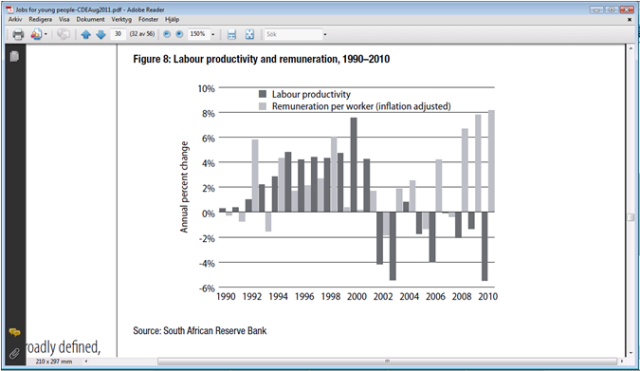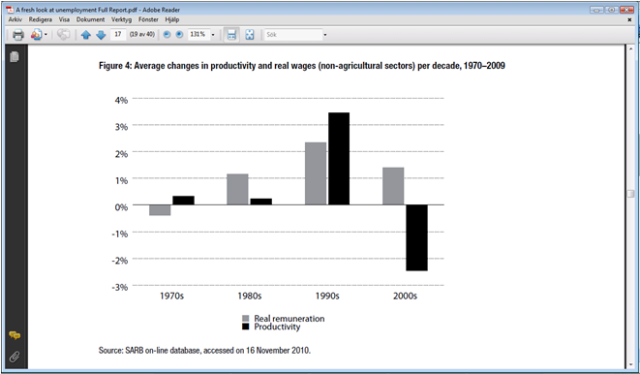The ‘productivity debacle' revisited: Arguing for cutting workers' wages, Adcorp and Centre for Development and Enterprise (CDE) mislead media and the public.
The Centre for Development and Enterprise (CDE) and the labour broker Adcorp continue to argue for decrease in the real wages on the basis of a claimed ‘fall in labour productivity' during the last decade (see two diagrams below). This is completely false.
SARB data shows that average labour productivity quarter by quarter, year on year, on the average has grown with over 3 per cent during 2000's. Real wage increases have on the average been lower than 3 percent. That is why the wage share of GDP (the yearly national income) has been falling for most of the period. Workers produce more and more and share less and less of the income.
Responding in July to an editorial in Business Day (20/7), the Alternative Information & Development Centre (AIDC) disclosed that two of the tables - ‘Employment in the non-agricultural sectors' and ‘Labour costs in the non-agricultural sectors', which the Reserve Bank (SARB) insists in publishing in every Quarterly Bulletin (QB) - contains data on employment and productivity that are completely wrong for the period 2000-2005. The Reserve Bank confirms that these tables must not be used for productivity calculations.
The SARB productivity assessment is based on the Quarterly Employment Statistics (QES) from Stats SA. The statistics has been corrected and revised three times, starting from 3rd quarter 2002. Why SARB continue to publish the two inaccurate tables is not clear. In a table placed at the end of the QB - ‘Labour in the non-agricultural sectors' - SARB publishes the productivity development data it regards as correct.
However, in the SARB's Monetary Policy Review (2 times a year) or the Quarterly Bulletins' diagrams and discussions on labour productivity, there is never a trace of the twisted data used by Adcorp and CDE.
During the 2000's, there is not one quarter where labour productivity has been recorded with a minus figure. Last time this happened, according to SARB, was 3rd quarter in 1992, ending a period of falling productivity 20 years ago.
Obviously, the ‘experts' at CDE and Adcorp's chief economist Loane Sharp have no idea what an average yearly minus 2.5% fall in labour productivity for 10 years in a row would mean. This would mean that the average worker each year during a decade - despite retrenchments, speed ups, excessive overtime, learning at job and the replacement of workers for machines - would produce less and less. Again: SARB data shows that average labour productivity quarter by quarter, year on year, on the average has grown with over 3 per cent during 2000's. Real wage increases have on the average been lower than 3 percent. Again: that is why the wage share of GDP (the yearly national income) has been falling for most of the period.
Business Day's editorial of today (14/9) uses data from Adcorp and opines that ‘the wage gap...economically, doesn't matter'. BD fails to understand that the extreme salaries to a small part of the population are the tip of an iceberg. Firstly, extreme salaries and bonuses distort the statistics over how far down the workers' share of the national income has fallen. Remuneration to the super-rich is also classed as wages in the National Accounts. Secondly, the income elite get a large part of their income from profits, not wages. A long term rising profit share and a corresponding falling wage of the national income (GDP) certainly matters, ‘economically'.
It is not possible to create a local and diversified industry, curbing mass unemployment and poverty, unless workers have an income to buy what is produced.
Two misleading diagrams from Adcorp and CDE

Above: Adcorp's chief economist Loane Sharp arguing for the wage subsidy to employers. He argues that youth wages, and all workers' wages, are too high. The alleged catastrophic fall in labour productivity, starts in 2002. But in reality, there is no fall in productivity. Above: Page 30 in "Jobs for Young People", Centre for Development and Enterprise brochure published August 2011 .Where the ‘inflation adjusted remuneration per worker' comes from is not clear.

Above: Centre for Development & Enterprise publishes completely wrong data over labour productivity (p.16 in the CDE brochure 'A Fresh Look at Unemployment - a conversation among experts', 2011 (visit: www.cde.org.za )). In reality, there is no fall in productivity in the 2000s. Every quarter, year on year, productivity grows at higher or lower rate.
Statement issued by Dick Forslund, Alternative Information & Development Centre (AIDC), September 14 2011
Click here to sign up to receive our free daily headline email newsletter

